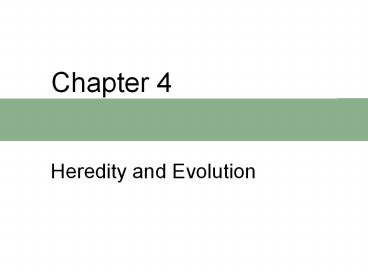Heredity and Evolution PowerPoint PPT Presentation
Title: Heredity and Evolution
1
Chapter 4
- Heredity and Evolution
2
Chapter Outline
- Genetic Principles Discovered by Mendel
- Mendelian Inheritance in Humans
- Non-Mendelian Patterns of Inheritance
- Mitochondrial Inheritance
3
Chapter Outline
- Modern Evolutionary Theory
- Definition of Evolution
- Factors That Produce and Redistribute Variation
- Natural Selection Acts on Variation
- Review of Genetics and Evolutionary Factors
4
Genetic PrinciplesDiscovered by Mendel
- Gregor Mendel (1822-1884) laid down the basic
principles of heredity. - Crossed different strains of purebred plants and
studied their progeny. - Worked with common garden peas and considered
only one trait at a time. - His work illustrates the basic rules of
inheritance.
5
Principle of Segregation
- Genes occur in pairs because chromosomes occur in
pairs. - During gamete production, members of each gene
pair separate so each gamete contains one member
of a pair. - During fertilization, the full number of
chromosomes is restored and members of a gene or
allele pairs are reunited.
6
Results of Crosses When One Trait at a Time is
Considered
7
Principle of Independent Assortment
- The distribution of one pair of alleles into
gametes does not influence the distribution of
another pair. - The genes controlling different traits are
inherited independently of one another.
8
Punnett Square
9
Results of Crosses When 2 Traits Are Considered
Simultaneously
10
Dominant Mendelian Traits in Humans
Condition Manifestations
Achondroplasia Dwarfism due to growth defects involving the long bones of the arms and legs trunk and head size usually normal.
Brachydactyly. Familial hyper- cholesterolemia Shortened fingers and toes. Elevated cholesterol levels and cholesterol plaque deposition.
11
Dominant Mendelian Traits in Humans
Condition Manifestations
Huntington disease Progressive degeneration of the nervous system accompanied by dementia and seizures age of onset commonly between 30 and 40 years.
Cleft chin Dimple or depression in the middle of the chin.
12
Recessive Mendelian Traits in Humans
Condition Manifestations
Albinism Inability to produce normal amounts of the pigment melanin.
Sickle-cell anemia Abnormal form of hemoglobin (HbS) that results in collapsed red blood cells, blockage of capillaries, reduced blood flow to organs, and, without treatment, death.
13
Recessive Mendelian Traits in Humans
Condition Manifestations
Cystic fibrosis Abnormal secretions of the exocrine glands, with pronounced involvement of the pancreas most patients develop obstructive lung disease.
14
Mendelian Inheritance in Humans
- Over 4,500 human trains are known to be inherited
according to Mendelian principles. - The human ABO blood system is an example of a
simple Mendelian inheritance. - The A and B alleles are dominant to the O allele.
- Neither the A or B allele are dominant to one
another They are codominant and both traits are
expressed.
15
ABO Genotypes and Associated Phenotypes
Genotype Antigens on red blood cells ABO blood type(phenotype)
AA, AO A A
BB, BO B B
AB A and B AB
OO None O
16
Pattern of Inheritance of Autosomal Dominant
Traits
17
Inheritance of anAutosomal Dominant Trait
18
Partial Pedigree for Albinism
19
Discontinuous Distribution of a Mendelian Trait
(ABO Blood Type)
20
Inherited Genetic Disorders
- Genetic disorders can be inherited as dominant or
recessive traits. - Dominant disorders are inherited when one copy of
a dominant allele is present. - Recessive disorders require the presence of two
copies of the recessive allele. - Recessive conditions that affect humans cystic
fibrosis, Tay-Sachs disease, sickle cell anemia,
and albinism.
21
Polygenic Inheritance
- Polygenic traits are continuous traits governed
by alleles at more than one genetic locus. - Continuous traits show gradations, there is a
series of measurable intermediate forms between
two extremes. - Skin color is a common example of a polygenic
trait it is governed by 6 loci and at least 12
alleles.
22
Mendelian Traits Comparedwith Polygenic Traits
23
Frequency of the Sickle-cell Allele Distribution
in the Old World
24
Malaria Distribution in the Old World
25
Genetic and Environmental Factors
- The genotype sets limits and potentials for
development and interacts with the environment. - Aspects of the phenotype are influenced by this
genetic-environmental interaction. - The environment influences many polygenic traits,
such as height. - Mendelian traits are less likely to be influenced
by the environment.
26
Levels of Evolution
- These levels are integrated in a way that
eventually produces evolutionary change - Molecular
- Cellular
- Individual
- Population
27
Mutation and Evolution
- Mutation is a molecular alteration in genetic
material - For a mutation to have evolutionary significance
it must occur in a gamete (sex cell). - Such mutations will be carried on one of the
individual's chromosomes. - During meiosis the chromosome carrying the
mutation will assort giving a 50 chance of
passing the allele to an offspring.
28
The Modern Synthesis
- Evolution is defined as a two-stage process
- The production and redistribution of variation
(inherited differences between individuals). - Natural selection acting on this variation
(whereby inherited differences, or variation,
among individuals differentially affect their
ability to reproduce successfully).
29
Factors That Lead to Increases in Allele
Frequencies
- Genetic drift occurs in small populations where
random factors cause significant changes. - Gene flow occurs when individuals migrate and
mate outside their original population. - Differential reproduction occurs when individuals
with particular alleles have more offspring than
others, leading to changes in allele frequency
and evolution.
30
New Technologies
- Polymerase chain reaction (PCR) makes it possible
to analyze and identify DNA as small as one
molecule and produce multiple copies of the
original DNA. - Recombinant DNA techniques allow scientists to
transfer genes from the cells of one species into
the cells of another. - Genetic manipulation is controversial due to
safety and environmental concerns.
31
(No Transcript)

